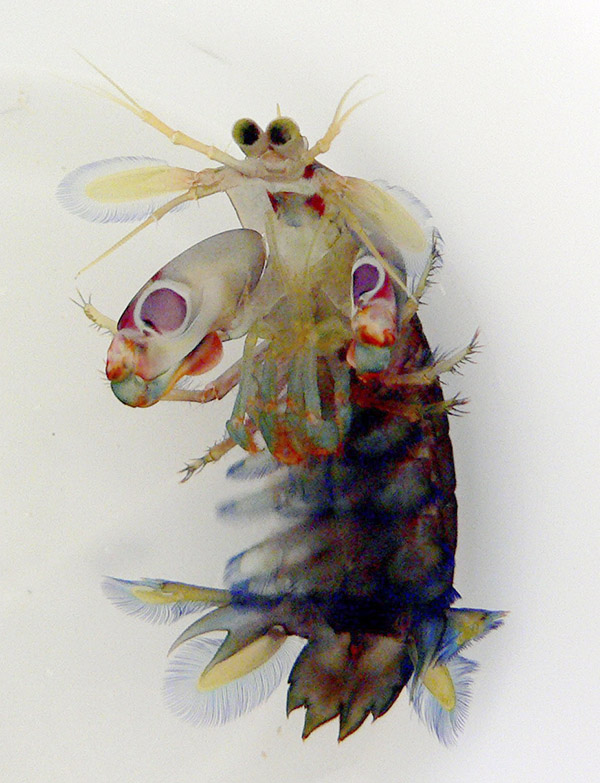Published in the Ocean Watch column, Honolulu Star-Advertiser © Susan Scott
May 25, 2016
Some years ago, I sailed to Australia’s Lizard Island, where researchers kindly allowed me to wander around their laboratory on my own. One day I found, kind of sitting up in a white cup, a 4-inch-long creature in a clown suit.
I had no idea what studies the biologists were conducting on the stunning animal, but whatever they were it deserved the attention.
I was looking at a peacock mantis shrimp.

The peacock mantis shrimp is the most colorful of the 400 or so mantis shrimp species found in the warm waters of the Indian and Pacific oceans, but researchers are interested in them all. The eyes, claws and intelligence of these crustaceans are so extraordinary that discoveries about them have made national news.
The mantis shrimp’s shape resembles a shrimp, and the folded front limbs look like those of the praying mantis.
Mantis shrimps are a type — and force — all their own. (Distantly related to shrimp, lobsters and crabs, they occupy their own order as stomatopods.)
The force comes in the form of two hinged claws, the front ends folded under the second segments like a praying mantis. Those tucked-under parts are either knives or clubs, depending on species.
When a mantis shrimp finds a fish or crab, it shoots out the cocked claws at bullet speed, and depending on weaponry, impales the fish or wallops the crab. Check out the video of this behavior at bit.ly/1RY3CO3.
Mantis shrimp zero in on prey with the most sophisticated vision of all animals, including us. To scan the surroundings, the two stalked eyes can independently swivel vertically and horizontally. Each eye has exceptional depth perception, plus 16 visual pigments (people have four) to see far beyond the human range, including ultraviolet and polarized light.
Besides toting lethal weapons and having nearly X-ray vision, mantis shrimp are also the Einsteins of crustaceans. In one study, researchers gave a peacock mantis shrimp two hollow plastic tubes of different colors and patterns with a plate of opaque glass covering the open end. One tube contained food.
The mantis shrimp had to break the glass, a natural behavior in this clubbing species, to get into the tube. The creature quickly learned which tube color and pattern contained food, consistently breaking open the right one and ignoring the other.
Some mantis shrimp live 20 years and mate for life.
Hawaii hosts 17 species (alas, no peacock). If you find one, admire it but don’t touch. Punching mantis shrimps can break aquarium glass and the stabbers’ nickname is “thumb splitter.”